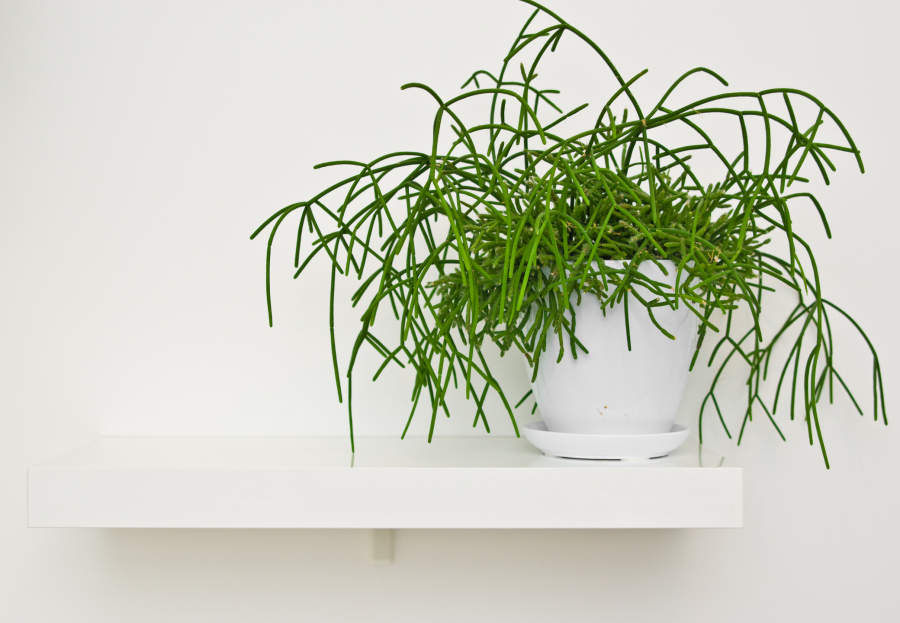
Rhipsalis is a low-light-tolerant plant but still benefits from good light to promote healthy growth. Place your Rhipsalis in a bright spot with indirect sunlight. While it can tolerate some direct sunlight, too much can scorch its delicate stems. If growing indoors, a north- or east-facing window is ideal, but if you lack a suitable window, artificial light will suffice. Prolonged exposure to harsh sunlight can cause sunburn, turning the stems yellow or brown. On the other hand, insufficient light can lead to spindly growth, with elongated stems and fewer new shoots. If your plant starts to look leggy, move it to a brighter location to help it regain its form.
Rhipsalis, like many cacti, does not enjoy sitting in water, and overwatering is a common cause of plant stress and root rot. Water your Rhipsalis only when the soil feels dry to the touch. During the growing season (spring and summer), this may be once every 1-2 weeks, while in the dormant months (fall and winter), watering should be reduced. When you do water, ensure the entire root system is moistened, but be sure to empty any excess water from the saucer or container to prevent root rot. If the stems become mushy or yellow, it’s a sign of overwatering. A well-draining cactus or succulent mix is best, and adding sand or perlite to regular potting soil can improve drainage.
Unlike desert cacti, Rhipsalis thrives in warm, humid environments. The ideal temperature range for Rhipsalis is between 60°F and 85°F (15°C - 29°C), and while it can tolerate brief drops in temperature, it should not be exposed to temperatures below 50°F (10°C). Since Rhipsalis naturally grows in humid jungles, it enjoys humidity levels around 50-60%. If your home is dry, especially during winter, you can increase humidity by using a humidifier, placing a tray of water with pebbles near the plant, or misting it occasionally. Be mindful of cold drafts from air conditioners or heaters, as sudden temperature fluctuations can stress the plant. If you want to boost humidity naturally, grouping Rhipsalis with other plants or keeping it in a bathroom with good light can help maintain moisture levels.
Rhipsalis is a relatively low-maintenance plant when it comes to feeding, but a little fertilizer during the growing season can promote healthier growth. Apply a balanced liquid fertilizer diluted to half strength once a month during the spring and summer. Since Rhipsalis slows its growth in fall and winter, it does not need fertilizing during those months. If the plant starts to yellow or shows signs of stunted growth, it may be getting too much fertilizer. In such cases, flush the soil with water to remove excess nutrients. A balanced, water-soluble fertilizer or a cactus-specific formula with low nitrogen content is ideal for this plant.
Rhipsalis requires minimal maintenance, but occasional pruning can help keep it looking neat and encourage fuller growth. Trim back any dead or damaged stems using clean, sharp scissors or pruning shears. If your plant has long, trailing stems, you can trim them to encourage bushier growth. Cleaning the stems occasionally by wiping them with a damp cloth will help remove dust and keep the plant looking fresh. Pruning is best done in spring or summer when the plant is actively growing, as cutting during dormancy may slow down recovery.
Rhipsalis is easy to propagate from cuttings, making it a fun and rewarding plant to multiply. To propagate, take a healthy stem cutting of at least a few inches using clean scissors or pruning shears. Allow the cut end to dry for 1-2 days to prevent rot, then plant it in a pot with well-draining cactus or succulent soil. Water lightly after planting and place the pot in a warm, bright location with indirect light. Within a few weeks, roots will start to develop. Alternatively, you can root the cutting in water before transferring it to soil. This method can speed up the rooting process and ensure a smoother transition to soil.
Rhipsalis spp. is non-toxic to pets, making it a great choice for homes with cats, dogs, or other animals. While it is safe, it’s still a good idea to keep the plant out of reach of curious pets to avoid accidental damage or chewing.
Q: Why are my Rhipsalis stems turning yellow?
A: Yellowing stems are often a sign of overwatering or poor drainage. Ensure your plant’s soil is well-draining, and avoid letting it sit in excess water. Also, check if the plant is receiving enough light.
Q: How often should I water my Rhipsalis?
A: Water when the top 1-2 inches of soil are dry. Typically, watering once every 1-2 weeks during the growing season is enough, but in winter, reduce watering to prevent overwatering.
Q: Can Rhipsalis grow in direct sunlight?
A: Rhipsalis prefers bright, indirect light. It can tolerate a small amount of direct sunlight, but too much can scorch the stems and cause damage.
Q: How do I propagate my Rhipsalis plant?
A: To propagate Rhipsalis, take a stem cutting, allow the cut end to callus over for a day or two, and plant it in a well-draining soil mix. Keep it in a warm, bright spot with indirect light and lightly water until roots form.